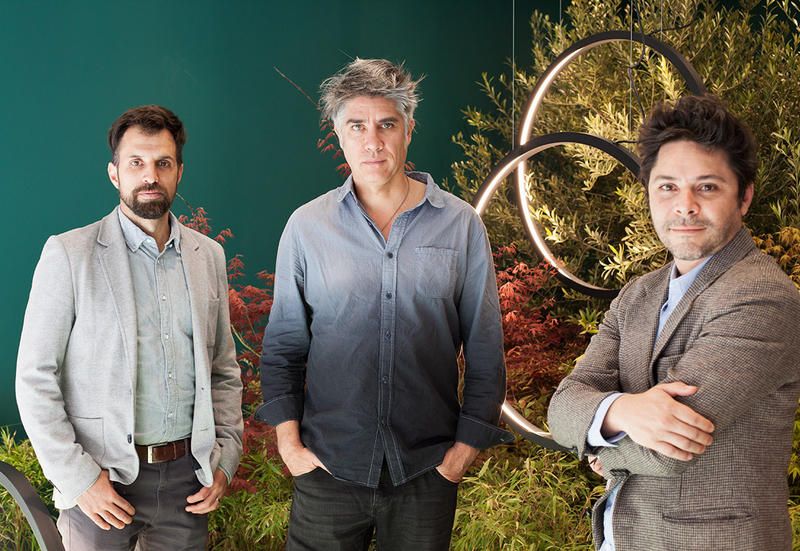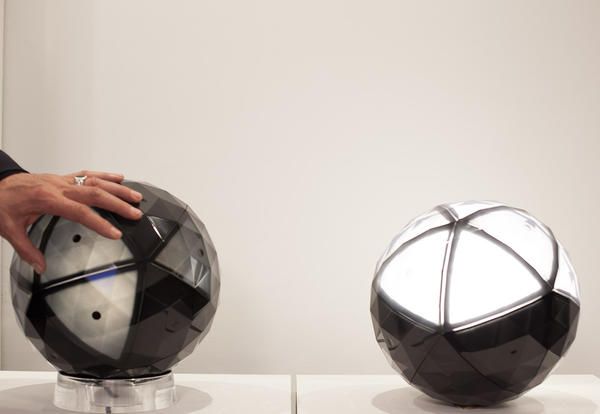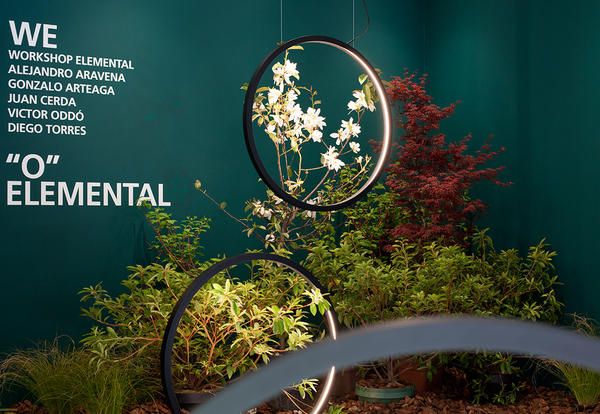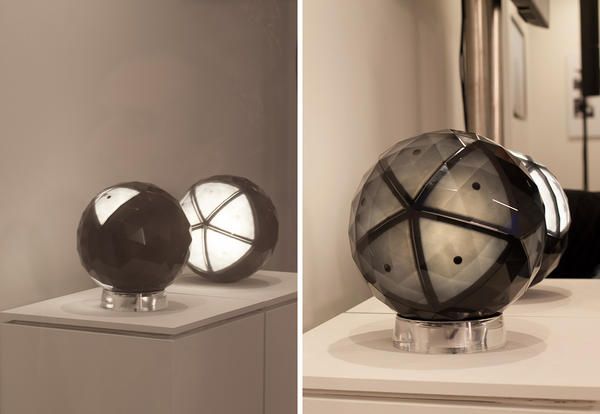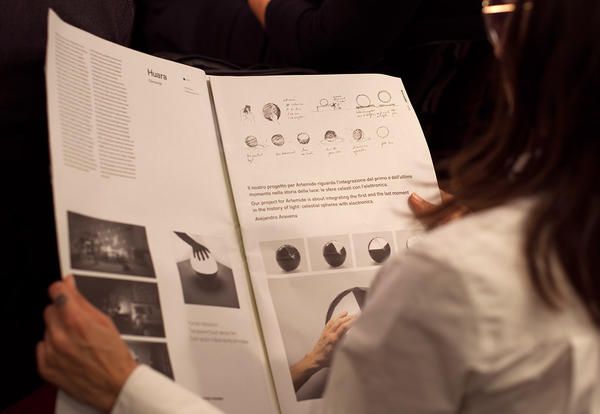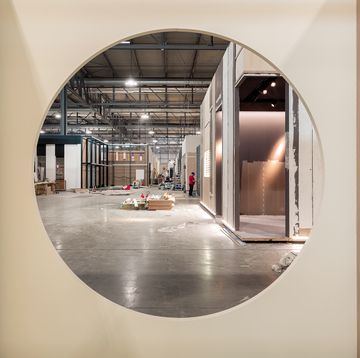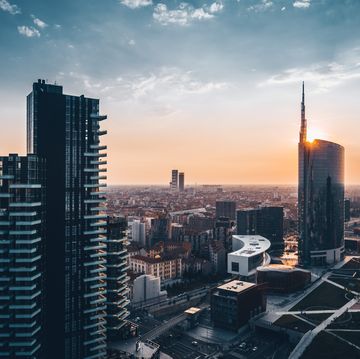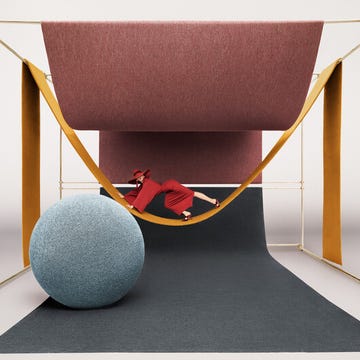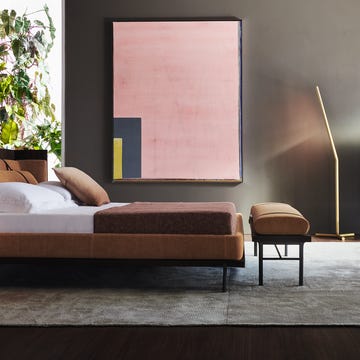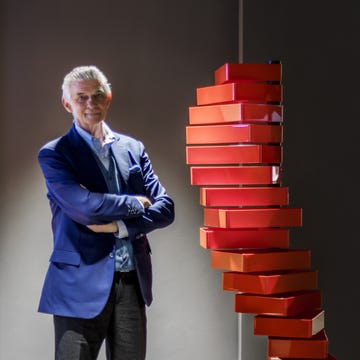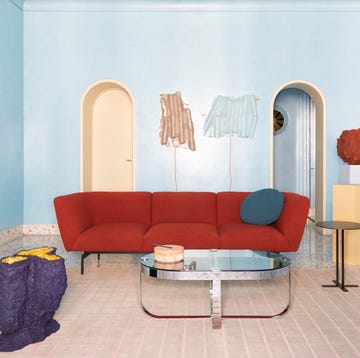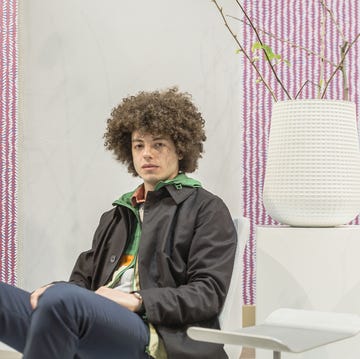The energy was palpable this morning when Alejandro Aravena and Carlotta De Bevilacqua spoke of their first meeting to discuss new designs, here at the press conference in the Showroom of Corso Monforte 19 for Milan Design Week 2018. They elaborated on the light, energy, and sparking creativity which guided the architects in both the ideation of futuristic concepts and the creation of stunning light pieces.
It’s no wonder then, that before addressing light design, the vice president of Artemide recounts an episode over coffee in the Giardini of the 2016 Biennale of Architecture (curated by the Chilean architect), in which her first question for Aravena was: “what do you know about photonics?” He knew very little about the subject — near to nothing — which made the conversation all the more interesting. Or at least much more interesting than your standard proposal for a new design lamp.
That’s all it took to catch the 2016 Pritzker Prize winner by surprise. Inclined to work through themes of sustainability, tolerance and resilience in the face of environmental emergencies, Carlotta De Bevilacqua has always maintained a great sensibility for the relationship between light and humanity. United by common ideals geared towards bettering the planet, the duo presented their two new projects under a concept of light as a future mode of communication and interaction, capable of transporting energy, data, and information. The first, O, is an outdoor lamp, and the second, Huara, a dark electronic sphere, activates at the touch. (Photos below)
Alejandro Aravena talks about the two Elemental projects for Artemide.
We started with the term photonics, which indicates how the light of today is much more than what we’re used to. It’s not just “a lamp”, but an interaction with sensors, software, and an App. It was something that we didn’t know about, but it pushed us to create a contemporary and evolutionary understanding of the relationship between light, the environment, and man.
Not entirely sure about the complex issue we were exploring, we organized a workshop where the company was able to provide as much information as possible — not just regarding photonics, but also optics, the history of light, the history of Italian light design, logistics, and modes of production. All this with the objective to explore the spectrum of possibilities for a project, be it an object, a system, or a technological application. In the end, we did a little bit of everything. Starting with the history of light, when mankind was accustomed to darkness, following the cycles of the sphere, the warm invention of the fire, and the electronic light.
The outdoor O light (pictured above), dedicated to public spaces, was born from a reflection on the necessity to preserve darkness in some way. The forces at play included the quantity of light necessary to illuminate a space, rendering it safe, but also maintaining a certain level of darkness for nature, for animals, and for ourselves. We designed a light for a public space that, when not in use, can be almost invisible — a light without the lamp so to speak. The use of a different variety of different sensors allows the light to appear only when necessary.
Meanwhile, with Huara (pictured above), which is still in the prototype phase, we reflected on the introduction of LED lights and the transition from electric to electronic. It’s a revolution that still hasn’t permeated society, which is why people still go looking for lightbulbs among the electric appliances and not in the electronics section. The name was derived from aymara, star and native population of the Atacama desert, the darkest and most arid place in the world and an homage to the source of humanity’s original light and the most avant-garde technology.
Alejandro, we’d like to elaborate on the relationship between design and architecture, your main field of action, and to know what it was like for you to really get involved with the design of an object.
I’ve already designed an object, the Chairless for Vitra, but it was my first time designing a light. The biggest difference between architecture and design is definitely scale. Architecture works with the relationship between the entire body and geography, while design is focused on certain parts of the body depending on the object. But in terms of forces in play that need to be integrated and translated, there’s no difference. We as designers need to investigate forces like necessity, desires, and contexts. Perhaps the difference is that speaking to these forces, was the same company. Artemide gave us the technical restrictions for construction, the optical notions to translate into light, and the objectives to reach. Translating all this in a concrete form, bridging the gap between the goal and the finished product was our job, just like in architecture.
So in respect to architecture, the company’s role here is fundamental.
The initial and final phase of the design are very closely linked with the company. They create the brief, then you translate that into a project, but it’s them that have to realize it. This relationship of continuous exchange was very stimulating for us, because we didn’t know in advance what would come from the project, we didn’t have expectations or prejudices. We didn’t use the company to create something, but we surprised ourselves and others, interpreting light with a tactile element in the Huara lamp. The touch interface is more than the simple on/off button and the light is activated in an intuitive way. There’s no need to explain, just like you don’t need to explain a touch tablet to a child. We used the tactile as a way of exploring — wherever you touch, the light is turned on, and you have to direct the face to illuminate in the correct direction. It’s an experience.
What is your impression of Milan Design Week and how the city reacts to the event?
I’ve always been shocked by the critical mass and energy that comes into play. This is much different than the world of architecture. In a week, design moves more people than architecture does in months, perhaps because it has a daily and more direct relationship with the user. Design has its own reflection on everyday life and sometimes that hides behind the mask of normality, but in reality, it drastically affects our lives — even if on a small scale. The power of it can really be felt, especially during this event.
What do you think about the new theme of the Biennale of Architecture — Freespace — curated by Grafton Architects? And what will your project look like?
We were really interested in the theme and how Freespace was identified as the highest value for architecture. That which isn’t constructed, but rather a free space that we inhabit collectively, because there are no walls to create barriers. Our governments should leave more unregulated free space. The message is very similar to what we do, to the practical and philosophical message we want to communicate. This idea that a community is appropriated according to the conscience and necessity of a space is a response to both the scarcity of means, especially economically, that obligates us to integrate interventions with individual initiatives, as well as the opportunity to create open systems that can be remodulated by making space that responds to customization before falling to deterioration.
You completed your studies in Italy, at the Istituto Universitario di Venezia and the Academy of Fine Arts. How have your studies in Italy influenced you?
We’re preparing a monograph for Phaidon, that should be released in October, and for which we’ve gone to search for material in old sketchbooks. I found some from that time and realized how much Italy was an original source. The true maestros are the buildings themselves. I came to Italy to draw and measure architecture. That period, for me, was an incredible time of learning and inspiration, especially if I think that not long before I was studying South American architecture. The exact opposite, it’s physically fragile but culturally strong in a different sense. That contrast really fascinated me.
Another project you’d like to design?
I have a lot of ideas, but I’m in no rush. I don’t want to move quickly. If you want to do something too fast, you can’t give it the depth that renders it truly different (in the sense of making a difference). The world is full of things, objects, and buildings. It’s better not to add useless things and take your time, giving form to the ideas so your contribution is more than just noise.
Opening picutre: ELEMENTAL, THE “DO-TANK” FOUNDED IN 2001 AND GUIDED BY ALEJANDRO ARAVENA, TOGETHER WITH HIS PARTNERS GONZALO ARTEAGA, JUAN CERDA, VICTOR ODDÒ, AND DIEGO TORRES WITHIN THE ARTEMIDE SHOWROOM IN CORSO MONFORTE 19.
